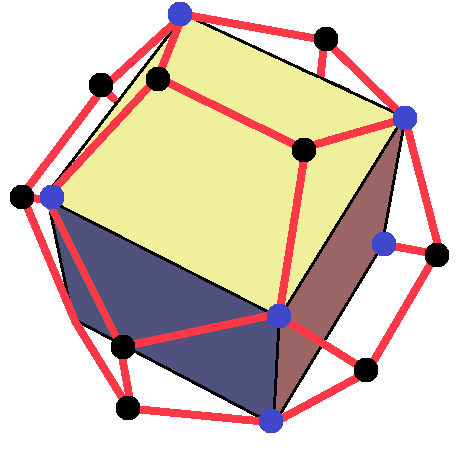He might be referring to Felix Klein's Lectures on the Icosahedron and the Solution of Equations of the Fifth Degree
Hadamard's Leçons de la Géométrie Élémentaire is available online.
Vol1 (Plane Geometry) and Vol 2 (Spatial Geometry)
There is a discussion of regular solids, but there's no discussion of algebra or Galois Theory.
These old-fasioned approaches to Galois Theory are really making a comeback. Here are books that I like
Here "Galois Field" is what we would call a "finite field" $\mathbb{F}_p = \mathbb{Z}/p\mathbb{Z}$ but notice that these can have group actions on solutions to equations. I think Felix Klein's discussion is the way to go since he will talk about modular forms and Galois theory.
I not 100% sure he show's the irreducibility of the quintic. The modern streamlined approach using Abstract Algebra is nicely written out by Emil Artin
This is where all the Galois Theory textbooks come from. Klein's approach is very unique.
In general the icosahedron has a large symmetry group. It is isomorphic to the alternating group $A_5 \simeq \mathrm{PSL}(2, \mathbb{F}_5)$.

This group could also be represented as fractional linear gransformations with elements in $\mathbb{F}_5$:
$$ \left\{ \frac{az+b}{cz+d} : ad-bc = 1\right\} $$
and this has an action on the hyperbolic plane $\mathbb{H} = \{ \mathrm{Im}(z) > 0 \}$

This is in Doyle-McMullen but $A_5$ also acts on the roots by permuting them.
$$ p(x) = (x - x_0)(x - x_1)(x - x_2)(x - x_3)(x - x_4) = 0 $$
The five cubes then via Galois Theory correspond to invariants, homogenous polynomals that could be made with the $x_i$. Klein proposes a geometric solution using algebraic geometry.
The algebraic manipulations are quite elaborate. For starts:
\begin{eqnarray*}
p_1 &=& x_0 + \epsilon^1 x_1 + \epsilon^2 x_2 + \epsilon^3 x_3 + \epsilon^4 x_4 \\
p_2 &=& x_0 + \epsilon^2 x_1 + \epsilon^4 x_2 + \epsilon^1 x_3 + \epsilon^3 x_4 \\
p_3 &=& x_0 + \epsilon^3 x_1 + \epsilon^1 x_2 + \epsilon^4 x_3 + \epsilon^2 x_4 \\
p_4 &=& x_0 + \epsilon^4 x_1 + \epsilon^3 x_2 + \epsilon^2 x_3 + \epsilon^1 x_4 \\
\end{eqnarray*}
and how these act under particular transformations of the complex plane:
\begin{eqnarray*} S: z &\mapsto &\epsilon z\\
T: z &\mapsto & \frac{-(\epsilon^1 - \epsilon^4) z + (\epsilon^2 - \epsilon^3)}{(\epsilon^2 - \epsilon^3) z + (\epsilon^1 - \epsilon^4)} \end{eqnarray*}
and these two should generate an action of $A_5$ on $\mathbb{H}$. And there's fair bit more which I can't summarize. There are two parameters:
$$ \lambda = - \frac{p_1}{p_2} = \frac{p_3}{p_4} \text{ and } \mu = - \frac{p_2}{p_4} = \frac{p_1}{p_3} $$
and we can see all these paramters should behave nicely under permutations of the numbers 1-2-3-4-5
Of course, there will be no solution by radicals.
See also this blog of Oliver Nash


